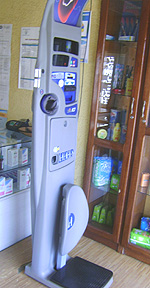Berte Uwizeye, a senior nurse working at the University teaching hospital of Butare, says that when presented with a wounded patient, the clinician should adhere to the basic principals of open wound management to initially treat the wound. There continues to be attempts to produce treatment protocols, that are important when added to basic wound treatment designed to enhance and shorten the time of wound healing.


Berte Uwizeye, a senior nurse working at the University teaching hospital of Butare, says that when presented with a wounded patient, the clinician should adhere to the basic principals of open wound management to initially treat the wound.
There continues to be attempts to produce treatment protocols, that are important when added to basic wound treatment designed to enhance and shorten the time of wound healing.
People should have a hint or understand the physiology of wound healing and the cellular effects of our treatments in order to make appropriate decisions about managing these traumatic wounds.
The decisions doctors make can enhance the healing process but inappropriate treatment may result in prolongation of wound healing or failure of wound closure.
When a person suffers an open wound, life threatening injuries must be addressed and the patient’s conditions stabilised prior to addressing the open wound.
During this initial evaluation and treatment of the patient, simply covering the wound with sterile saline soaked gauze will keep the wound moist and limit further wound contamination.
Uwizeye, who has practiced nursing for over ten years, explains that to properly assess and initially treat a wound, the patient is ideally placed under general anaesthesia.
The appropriate wound treatment for an individual patient will be determined by the health status of the patient, the condition of the wound and the financial ability.
The condition of the wound is influenced by the degree of contamination and the likely bacteria present as influenced by the location and conditions of the wounding, the relative size of the wound and how long the wound has been open.
The condition of the tissues and the local blood supply will depend on the type of injury present. Such injuries may present in form of abrasion, avulsion, incision, laceration, crushing, puncture, burn or gunshot wound.
The condition of the surrounding local tissues will determine if there is adequate skin available for a tension free closure without the accumulation of dead space.
Uwizeye advises use of sharp dissection or scalpel blade to remove obviously dead and necrotic tissue and devitalised skin to the level of healthy bleeding tissue.
Grossly contaminated tissue may also be sharply dissected at it’s time. Great care should be taken when debriding tissues around nerves, tendons and vessels.
It is best to be conservative and serially debride around these structures employing chemical as well as mechanical debridement.
Tissue and skin viability may be difficult to assess in the early stages so debridement may be delayed 48 to 72 hours to allow the tissues to declare their viability.
Washing by use of sterile water soluble gel should be placed in the wound and the surrounding hair should be liberally clipped.
The skin surrounding the wound should be cleaned with an antiseptic soap being careful not to let soap enter the wound which will cause additional cellular damage.
Wound lavage or washing should be aimed at providing a large volume to remove debris and bacteria from the wound. Tap water can be used as an inexpensive way to deliver large volumes of fluid to an open wound.
Tap water is hypotonic and non-sterile but has been used in clinical studies without obvious adverse effects on healing or infection rates.
Sterile saline solution is commonly used as a lavage fluid but has shown in vitro toxicity to fibroblasts due to its acidity. Lactated ringers solution is a sterile isotonic fluid that is less acidic than saline. Additives may be added to the lavage solutions to add antimicrobial activity to the lavage solutions.
Chlorhexadine 2% solution will provide a wide spectrum of antimicrobial and sustained residual activity that is not inactivated by organic material. Chorhexadine precipitates in electrolyte solutions but this does not appear to affect it antimicrobial properties.
Primary closure is used only for clean wounds or wounds that can be debrided and converted to a clean wound. Delayed primary closure is applied if the wound is clean enough to close primarily, the wound is managed open until it is clean and can be closed prior to the formation of granulation tissue (3-5 days).
Uwizeye adds that secondary closure is applied when a contaminated wound is treated open until the wound is clean and closed after the formation of a granulation tissue bed. The wound is allowed to heal by wound contraction and re-epithelialisation.
When a wound is clean enough to close it may be closed with local tissues, local and axial pattern skin flaps, free skin flaps or skin grafts. When a wound is clean enough for closure, active or passive drains may be required to control dead space.
Contact: josephmunich06@yahoo.co.uk


